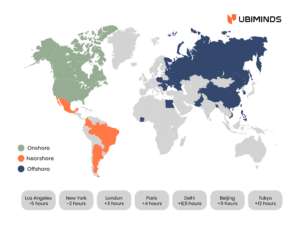The EdTech sector demands innovative, efficient, and secure solutions to stay competitive. Nearshore app development for EdTech connects software teams with Latin America’s skilled talent, enabling faster product delivery, cost-effective scaling, and regulatory compliance while addressing unique educational software trends in the EdTech industry. Discover why nearshoring drives success!
[ez-toc]
Overcoming EdTech’s Industry-Specific Challenges
EdTech apps often face challenges like scaling for high usage, adapting to global educational standards, and integrating with legacy systems. These EdTech app solutions require technical expertise to navigate complex demands while creating impactful educational experiences for the target audience.
Nearshore teams bring agile expertise, ensuring apps can handle growth, meet diverse regulatory needs, and modernize seamlessly. For example:
Scaling Infrastructure
Nearshore developers leverage app scalability solutions and cloud platforms like AWS to ensure educational technology apps can handle spikes in user demand, such as students accessing learning materials during exam periods. (Sidenote: You may want to check our Microservices Architecture article too.)
Compliance with Global Standards
Developers are trained in FERPA and GDPR requirements, ensuring your app meets worldwide compliance needs. If you’re curious on how there’s compatible legislation in other countries, read this comparison on PII compliance per country.
Integration with Legacy Systems
Latin American experts excel in bridging modern technologies with older systems, ensuring seamless transitions. Talking of which, there’s usually the challenge of connecting to the Edtech Ecosystem of admin software, Learning Management Systems (LMS) and Student Information Systems (SIS) to assessment tools, video conferencing platforms, and content management systems. More on our Edtech Integrations piece.
Other Industry-Specific Challenges
Dive deeper with our related articles:
- How Can EdTech Companies Grow Their Market Share in Such a Competitive Scenario?
- The Edtech Double Bottom Line: Sustainable, transformational, outstanding, and permissionless education innovation
Why Use Nearshore Development for EdTech?
The EdTech industry is experiencing rapid growth, driving the demand for innovative software solutions to enhance learning experiences. To stay competitive, EdTech companies need to prioritize efficient development and delivery of high-quality applications.
Through nearshore software development, EdTech companies can access global EdTech talent, enabling the creation of innovative learning management systems that keep students engaged and facilitate adaptive learning styles.
Nearshoring, particularly with Latin America, offers several strategic advantages for EdTech companies:
Cultural Alignment and Time Zone Synergy: Why It Matters
Smooth collaboration is crucial in EdTech app development. Nearshore teams in Latin America offer cultural alignment and shared time zones, reducing miscommunications and ensuring faster project delivery.
Shared cultural values and similar time zones facilitate seamless communication and collaboration. This leads to smoother project management, quicker decision-making, and better understanding of project requirements. Latin American countries, especially those in the same time zone as the Eastern Standard Time, offer a seamless collaboration experience.
By partnering with staff augmentation and software outsourcing Latin America providers, EdTech companies in the United States benefit from reduced delays and more responsive communication cycles.
- Why it’s important: Effective communication prevents misunderstandings and delays.
- What happens if not addressed: Disconnected teams and project slowdowns can arise.
- Why nearshoring helps: Shared time zones and cultural values enhance team collaboration.
Without cultural alignment, missteps in communication can delay projects. Nearshoring guarantees streamlined collaboration, keeping your EdTech project on track.

When comparing Onshore, Nearshore and Offshore Services, Brazil’s Location and TimeZone overlap are a bonus to US companies
Skilled Talent Pool: The Key to Innovation in EdTech
Latin America boasts developers skilled in EdTech technologies like React, Python, and AWS, ensuring your team has access to cutting-edge expertise.
- Why it’s important: The right expertise ensures high-quality apps.
- What happens if not addressed: Underqualified teams may deliver buggy or ineffective software.
- Why nearshoring helps: Latin America offers deep EdTech expertise and advanced tech skills.
Latin America boasts a growing pool of talented developers with deep technical expertise in EdTech technologies, including React, Angular, Vue.js, Node.js, Python, Ruby on Rails, iOS (Swift, SwiftUI), Android (Kotlin, Java), AWS, Azure, and Google Cloud Platform.
Many Latin American developers are well-versed in agile methodologies and DevOps practices, ensuring efficient and high-quality software delivery. These professional developers have extensive skill sets, including fluency in leading programming languages and experience in CI/CD pipelines for EdTech to ensure continuous app development and quality.
A lack of skilled developers can lead to subpar applications. Nearshore app development provides talent tailored to your EdTech needs, ensuring innovation and quality.

Ensure your hiring teams know how to interpret technical test results and interview answers. Provide guidelines on what to look for: proficiency in specific programming languages, problem-solving skills, and cultural fit. Training your team to read between the lines can help avoid bias and ensure qualified candidates move forward. Photo by Jonathan Kemper.
Cost-Effective Solutions: Maximizing ROI for EdTech Companies
Budget constraints shouldn’t limit your EdTech goals. Nearshore development offers flexible engagement models and competitive pricing without compromising quality.
- Why it’s important: Budgets directly impact development scope and timelines.
- What happens if not addressed: Overpriced solutions can stall growth.
- Why nearshoring helps: Competitive pricing balances cost and quality.
There are flexible engagement models out there. You can choose from staff augmentation, dedicated development teams, or project-based hiring to match your specific needs at different times. Combining them allows you to match your specific needs without overextending budgets.
High costs can hinder app development progress. Nearshoring enables EdTech companies to optimize budgets while achieving their development objectives.
Accelerated Time-to-Market: Agile Development That Delivers
EdTech market growth is led by speed. The faster your app is developed, tested, and launched, the quicker you can address market needs and seize opportunities.
- Why it’s important: Delays can mean losing ground to competitors.
- What happens if not addressed: Missed launches reduce market impact.
- Why nearshoring helps: Agile practices and overlapping hours keep projects on track.
Adding more hands on deck through nearshoring is a strategic way to accelerate progress while maintaining quality. Latin American nearshore providers offer flexible engagement models—such as Talent-as-a-Service (TaaS) and software development outsourcing—to match your project’s specific requirements.

Tech leaders balance stability and groundbreaking kaizen strategies to transform markets, drive business innovation, and deliver market-changing solutions. Photo by Eden Constantino.
Data Security and Compliance: Building Trust in EdTech
With education data under scrutiny, robust security measures and compliance with regulations like GDPR are essential for EdTech success. Developers who prioritize creating secure EdTech software protect sensitive information, meeting the expectations of educators, parents, and students alike.
- Why it’s important: Trust and reputation hinge on secure, compliant systems.
- What happens if not addressed: Security breaches can result in fines or lost users.
- Why nearshoring helps: Latin American teams specialize in EdTech compliance.
Reputable nearshore providers prioritize data security, place robust security measures and adhere to industry standards like GDPR and CCPA.
Nearshore teams can also be trained to comply with specific regulations in the education industry regulations. Ubiminds, for instance, is already specialized in such and thus has become the main provider of tech talent for Edtech Teams.
Security breaches and non-compliance can erode trust. Nearshore teams prioritize regulatory adherence, safeguarding your EdTech applications.
Why Engagement Models Matter
Each project has unique demands, from tight deadlines to varying workloads, and nearshore providers allow you to scale resources effectively. Here’s when to choose different engagement models:
Everyone knows stretched teams risk burnout, errors, and missed deadlines. Talent-as-a-Service means bringing in full-time like team members, but without the employment risk.
Why it’s interesting: If your in-house team is stretched thin, but you want to retain full project control, TaaS offers on-demand access to skilled professionals. These developers integrate seamlessly with your team, boosting capacity during critical phases.
When to use it:
- Your team has a clear roadmap but lacks bandwidth to execute it.
- You need niche expertise to handle specific technical challenges.
- You require flexibility to ramp up or down resources as your project evolves.
Best for when you might delay your launch due to limited internal capacity, and it’s a small, limited scope you don’t need too much control over.
Why it’s interesting: When you need a turnkey solution, outsourcing offers end-to-end project management. The provider takes full responsibility for planning, developing, and delivering the application.
When to use it:
- You lack the in-house capacity to oversee development.
- You need a fast-tracked solution without managing day-to-day execution.
- Your focus is on outcomes rather than managing processes.
Choosing the right engagement model depends on your project goals and internal capacity. Nearshore providers in Latin America offer both TaaS and full outsourcing options, giving you the flexibility to scale efficiently and meet deadlines without compromising quality. Whether you need extra hands to support your team or a fully managed solution, nearshoring ensures your EdTech app is delivered on time and on target.

Each hiring type—short-term, long-term, and full-time—fulfills a unique role in software development. Short-term contractors offer flexibility and scalability, long-term contractors bring expertise without the commitment of full-time employment, and full-time employees support continuity and loyalty. Understanding their differences is critical for resource allocation. Photo from Pixabay.
Key Considerations for Nearshore App Development
Nearshore app development offers a strategic advantage for EdTech companies seeking to enhance their educational technology apps. However, to fully harness the benefits, careful planning and communication are essential.
Fostering a culture of continuous improvements ensures your EdTech product development remains ahead of evolving educational software trends.
- Effective Communication: Establish clear communication channels and use collaboration tools to facilitate seamless teamwork.
- Cultural Understanding: Foster a strong understanding of cultural nuances to build effective working relationships.
- Data Security and Compliance: Ensure that your partner prioritizes data security and adheres to relevant regulations.
- Project Management: Implement robust project management methodologies to ensure timely delivery and quality.
Keeping yourself and the team attentive to these items can maximize the potential of nearshore software development to build innovative, secure, and scalable apps. Establishing clear communication, prioritizing education-focused app development, and leveraging global EdTech talent are essential steps to delivering exceptional outcomes.
We dive deeper in these topics in the articles below:
- Internationalization Strategy: Here’s why American and Canadian EdTechs are hiring tech talent from LatAm – and 5 reasons to do the same
- Talent Acquisition: The Power of EdTech: Building High-Performance Software Teams for Educational Transformation
- Learning & Development: Tech Team for EdTechs: What Skills and Competencies Should We Develop in Team Members?

Planning your workforce, you ensure scalability, skill diversity, and team adaptability, which are all crucial for driving SaaS expansion. Latin America, with its cultural proximity and strategic time zone advantages, offers a competitive edge in this regard. Photo by The Connected Narrative.
FAQ on Nearshore App Development for Edtech
Nearshore app development has become a go-to solution for many EdTech companies looking to innovate and scale efficiently. But how does it work, and why is it particularly effective for the EdTech industry?
If you’re ready to tap into Latin America’s IT staffing expertise for your next project, reach out to Ubiminds and discover how we can bring your vision to life.
Partner with Ubiminds for EdTech Success
Leveraging agile teams in EdTech, nearshore providers offer education-focused app development services tailored to meet the needs of EdTech startups and established companies alike.
Ubiminds specializes in Latin America IT staffing, making it the top choice for companies needing top EdTech developers to support artificial intelligence (AI) innovations and scalable solutions for both web apps and mobile devices.
By partnering with Ubiminds, you can:
- Access a Global Talent Pool: Tap into a vast pool of skilled developers with expertise in EdTech technologies.
- Streamline the Hiring Process: Our efficient hiring process ensures you find the right talent quickly.
- Ensure Quality and Security: Benefit from our rigorous quality assurance processes and commitment to data security.
- Focus on Your Core Business: Outsource non-core development tasks to our experienced teams.
Ready to elevate your EdTech business? Contact Ubiminds today to discuss your specific needs.

International Marketing Leader, specialized in tech. Proud to have built marketing and business generation structures for some of the fastest-growing SaaS companies on both sides of the Atlantic (UK, DACH, Iberia, LatAm, and NorthAm). Big fan of motherhood, world music, marketing, and backpacking. A little bit nerdy too!










